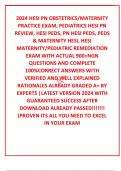2024 HESI PN OBSTETRICS/MATERNITY
PRACTICE EXAM, PEDIATRICS HESI PN
REVIEW, HESI PEDS, PN HESI PEDS, PEDS
& MATERNITY HESI, HESI
MATERNITY/PEDIATRIC REMEDIATION
EXAM WITH ACTUAL 900+NGN
QUESTIONS AND COMPLETE
100%CORRECT ANSWERS WITH
VERIFIED AND WELL EXPLAINED
RATIONALES ALREADY GRADED A+ BY
EXPERTS |LATEST VERSION 2024 WITH
GUARANTEED SUCCESS AFTER
DOWNLOAD ALREADY PASSED!!!!!!!
(PROVEN ITS ALL YOU NEED TO EXCEL
IN YOUR EXAM
,
, The practical nurse (PN) is observing a group of children at a day care center to determine whether
children are achieving developmental milestones. Which activity should the PN identify as typical for a 2
year old child's cognitive development?
a) has a vocabulary of about 1000 words
b) uses short sentences to express self
c) initiates play with other children
d) recognizes right and wrong Answer: B
Rationale:
Although children develop at different rates, a 2 year old typically uses short sentences to express
independence and control (B) and has a vocabulary of up to 300 words, not (A). At the age of 2 years, a
toddler is developing negativism without understanding the concepts of right and wrong (D). A 2 year
old engages in solitary play and parallel play but does not initiate or cooperative with other children (C)
in play, which begins with socialization of the preschool child.
The practical nurse (PN) is interviewing a 10 year old girl about school and her extracurricular activities.
She responds, "I like school. I play the flute in the school band, and I take tennis lessons." Based on
Erikson's psychosocial theory, the PN identifies that this child is in what stage of development?
a) identity
b) intimacy
c) industry
d) initiative Answer: C
Rationale:
Erikson's stage of industry (C) for a school aged child is demonstrated by successful participation in new
skills and peer activities, such as sports and band. (A, B, and D) are achieved in other age groups.
The practical nurse (PN) identifies an increased frequency of otitis media (OM) is children who are
coming to the clinic. Based on this finding, which age group should the PN monitor a child for signs and
symptoms of OM?
a) toddler
b) preschooler
, c) school ager
d) adolescent Answer: A
Rationale:
Infants and toddlers (A) are most prone to otitis media due to the anatomical structure of the
eustachian tube that allows fluid and microbial entry into the middle ear. (B, C, and D) are most
susceptible to acute infectious diseases acquired through environmental transmission from daycare or
school settings.
The practical nurse (PN) collects information about infant growth and development milestones for
infants who come to the clinic for a well child visit. Which findings should the PN document as normal
infant growth and development?
a) maternal iron stores persist during the first 12 months of life
b) anterior fontanel closes by 6 to 10 months of age
c) binocularity is well established by 8 months of age
d) birth weight double by age 5 months and triples by 1 year Answer: D
Rationale:
Infants gain approximately 1.5 pounds/month until age 5 to 6 months, when the birth weight doubles,
and by 1 year of age, the birth weight usually triples (D). The anterior fontanel closes by 12 to 18 months
of age, with the average being 14 months, not (B). Binocularity begins to develop by 6 weeks of age and
should be well established by age 4 months, not (C). Maternally derived iron stores ares present for the
first 5 to 6 months and gradually diminish, which results in an expected lowered hemoglobin levels
toward the end of the first 6 months (A).
Which nonfood item is the most common cause of respiratory arrest in young children?
a) latex balloons
b) broken rattles
c) buttons
d) pacifiers Answer: A
Rationale:




